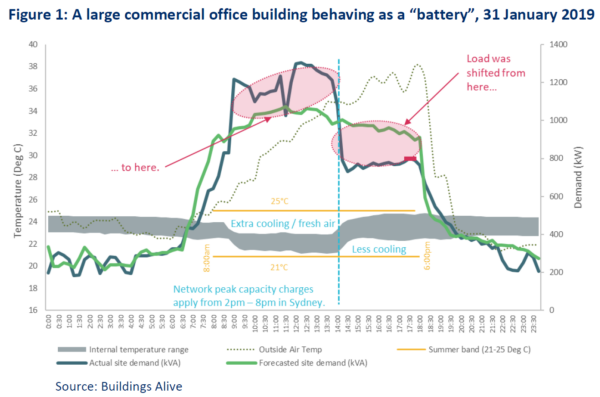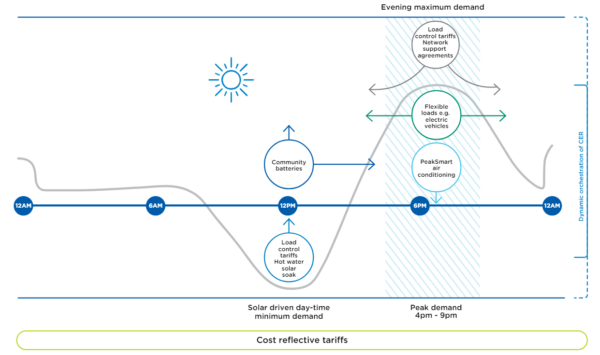The researchers behind the new “Buildings as Batteries” paper claim that a load shift in Australia to the middle of the day would save AUD 1.7 billion ($1.1 billion) per year. They claim it would also add additional peak capacity equivalent to 52% of Australia’s existing coal-generation fleet and significantly reduce the country’s greenhouse gas emissions from electricity.
“Luckily for everyone except the owners of the coal-fired power stations, it is relatively easy to shift a lot of electricity demand from late afternoon to the middle of the day,” he said. “Our research shows big commercial buildings are particularly good at shifting their daily electricity demand around, to take better advantage of the cheap, clean power that is so abundant in the middle of the day.”
The paper cites an example of a large office tower in Sydney, where the building managers were told that electricity demand would likely be extremely high on a hot summer day in 2019. In response, the internal temperature set point of the building was lowered by 1 degree from 8.30 a.m. to 2 p.m. The figures show that the building used more electricity earlier in the day and reduced demand by 200 kW relative to forecasts from 2 p.m. to 6 p.m.
“The building effectively operated as a battery with capacity of at least 800 kWh,” the report said. “We estimate this led to savings of AUD 111 and 221 kg CO2e in emissions in just one day in just that one building. A battery of that size would cost around AUD 500,000. Extrapolating across Australia, if 33% of the energy buildings use in the late afternoon in summer were shifted to the middle of the day, that would deliver new peak capacity in the energy market of almost 12 GW.”

The report said that if a government program to develop the demand side in the National Electricity Market was launched this year, it could organize load shifting in 30% of Australia’s institutional grade office buildings by 2025, rising to 90% in 2027.
The researchers said that such a program, which would deliver about 2.6 GW of flexible capacity by the end of 2026, could be secured through relatively minor changes to building management practices, such as cooling large office buildings earlier in the day and then allowing their temperature to rise back to normal levels across the afternoon.
The researchers warned that changes to policy and regulation would be required, as current efficiency ratings systems are holding back the adoption of new technologies by failing to recognize the financial, emissions and grid stabilizing potential of smart, grid-interactive buildings.
Buildings Alive Chief Executive Officer Craig Roussac said the solutions to this problem exist already, and the country just needs to start using them.
“If we don’t harness the potential of smart, grid-interactive buildings, Australians will pay the price through higher network costs, more expensive electricity and increased carbon pollution,” he said. “Australia has had world-leading building efficiency ratings systems in the past, but they have not evolved. Most buildings can double their energy demand at times of the day when it’s abundant and halve it when networks are constrained. This is a massive service they can offer.”

The report recommends a range of policies to support load shifting and demand response, including having NABERS develop and implement an updated building efficiency rating system that recognizes the potential of these measures.
The researchers also said that governments should implement demand flexibility in their own buildings and work with energy innovators and the property sector to accelerate development of load shifting and broader demand response. They also said federal government agencies like ARENA and the CEFC could help by soliciting for related project proposals and through concessional finance.
The report said it would be necessary for the electricity market operator, regulators and rule makers to ensure that load shifting can compete in the wholesale demand-response market.
This content is protected by copyright and may not be reused. If you want to cooperate with us and would like to reuse some of our content, please contact: editors@pv-magazine.com.









By submitting this form you agree to pv magazine using your data for the purposes of publishing your comment.
Your personal data will only be disclosed or otherwise transmitted to third parties for the purposes of spam filtering or if this is necessary for technical maintenance of the website. Any other transfer to third parties will not take place unless this is justified on the basis of applicable data protection regulations or if pv magazine is legally obliged to do so.
You may revoke this consent at any time with effect for the future, in which case your personal data will be deleted immediately. Otherwise, your data will be deleted if pv magazine has processed your request or the purpose of data storage is fulfilled.
Further information on data privacy can be found in our Data Protection Policy.